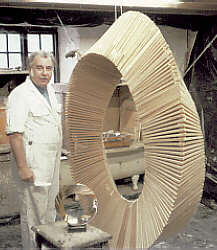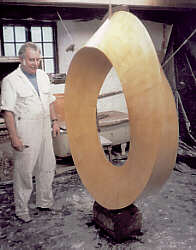
An earlier version of Minkowski's world-lines:
The Fates weaving the threads of destiny.
(Painting by Alfred Agache, late 1800s. Musée des Beaux-Arts, Lille)
PART 1B: Minkowski's words are in boldface.

"By the concepts "space" and "time" the x, y, z-manifold t=0 and its two sides t > 0 and t < 0 become separated."
That is, the world can be split into past, present, and future.
"If for simplicity we keep the zero point of time and space fixed, then the first mentioned group of mechanics [space is the same everywhere and physics does not depend on the choice of coordinate system] means that we can give any rotation around the origin to the x, y, z-axes in t=0 corresponding to the homogeneous linear transformations of the expression x² + y² + z² into itself."
This is of course the expression for the square of the radius of a sphere; transformations which leave it unchanged are rotations, because an unmarked sphere looks the same no matter how it is rotated. We have already noted that the relative distance between two points (and thus all of Newtonian physics) is the same whether, for example, the origin of our coordinate system is Greenwich or someplace else (translational invariance). In the same way, relative distance is obviously unchanged when we rotate the coordinate system through an angle: say, use magnetic north instead of true north. Such "rotational invariance" (the laws of physics do not depend upon the direction the observer happens to be looking) is responsible, by Noether's Theorem, for conservation of angular momentum.
"But the second group or invariance [Galilean invariance] means that without changing the expressions of the laws of mechanics, we can replace x, y, z, t by x − α t, y − β t, z − γ t, (α, β, γ being any constants whatever)."
This is simply a mathematical way of saying that, according to Galileo, absolute motion cannot be observed. The constants α, β, and γ are uniform velocities in the x, y, and z directions. If two coordinate systems are moving with relative speed α in the x direction, like the shipboard and onshore reference-frames in the video about Galilean invariance, the same object will have position x in one system and x - α t in the other, but the laws of physics are unchanged.
"The time-axis can accordingly be given any direction whatever toward the upper half-world t > 0 ."
This is a subtle point, but a very important one. The three dimensions of space are related to each other by rotations. If one is looking north, one can turn (rotate) to look northeast; in doing so, one sees some parts of the horizon that were previously too far south to be seen. The rotation in a way "mixes" north and south. But time seems to be different; no matter how one twists about, the past is still past, the future still future, and (most importantly for Minkowski's purposes) the present is still the present -- or so it seems, and so Newton took as given. Thus if time is a fourth dimension, it must be somehow immune to rotations, as though it were "outside" geometry.
Imagine a picture which somehow represents the entire Newtonian universe at a particular epoch t, another picture depicting it a moment later, another showing it a little later yet, and so on. If one stacks these pictures along the fourth dimension like playing cards, one has the four-dimensional space-time Minkowski has so far been describing. For convenience, let us suppose that these slices of space-time really are playing cards.
Now stick a pin through the whole deck. Clearly if the cards were in order before, they remain so with the pin through them. If the pin is exactly parallel to the time-axis, one could just call it "time". It passes through the low-numbered cards of each suit -- the early periods of history -- and then through the high numbered ones -- the later periods. But what if the pin is not parallel to the time-axis?
So long as the pin goes through every card, it obviously goes through them in the same order: low numbers before high. Moreover, sticking a pin through the deck cannot change one card into another, even partly: a Ten remains a Ten and never becomes "partly a Nine". Everything is just the same as in the previous case.
Clearly, we could stick a pin through the deck in any direction not parallel to the cards and call it "time" just as though it were aligned the t axis.
In the Twentieth Century, a special term will be introduced to describe exactly this situation: "fibre bundle". The pin is the "base" of the deck ("bundle") and the cards are its "fibres". Each fibre (or card, or snapshot of Newton's universe) is sequenced along the base, but there is no way to connect the base uniquely with a particular direction: any way it points, it will keep the fibres in order and distinct. Time is the base of the Newtonian space-time fibre-bundle, and therefore has no unique direction in the four-dimensional world. Space at any given moment is a fibre, and cannot be mixed with space at any previous or later period.



Some readers may find this terminology odd: surely the "fibres" -- two-dimensional playing-cards or three-dimensional models of the universe -- are considerably less "fibrous" than the one-dimensional base (stick-pin or time-axis)! In fact, the dimensionalities of the fibres and the base do not matter for the definition of the bundle. The people who devised the term were thinking of a two-dimensional surface for the base manifold, and one-dimensional fibres sticking through it, as in this image from the Japanese Wikipedia.

TIME AND SPACE, by Hermann Minkowski